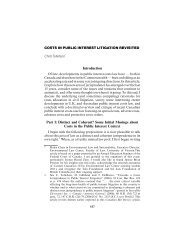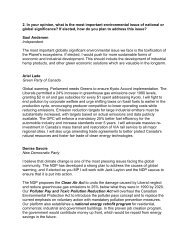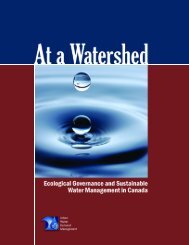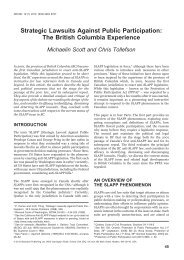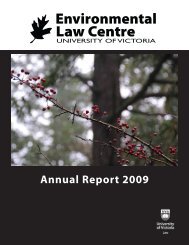Peeling back the Pavement - POLIS Water Sustainability Project
Peeling back the Pavement - POLIS Water Sustainability Project
Peeling back the Pavement - POLIS Water Sustainability Project
Create successful ePaper yourself
Turn your PDF publications into a flip-book with our unique Google optimized e-Paper software.
HOW TO USE THE BLUEPRINTS<br />
The following blueprints outline a process for weaving <strong>the</strong> three principles of <strong>the</strong><br />
Rainwater City into a coherent approach to rainwater management. The three<br />
principles, as introduced already, are:<br />
Build it better let rain do <strong>the</strong> work watershed governance<br />
Although each aspect is discussed separately, <strong>the</strong> three principles should be viewed<br />
as an interconnected whole. Each of <strong>the</strong> following sections begins by describing<br />
how <strong>the</strong> principle addresses its corresponding problem as identified in <strong>the</strong><br />
Stormwater City section. Specific actions for local governments based on each of<br />
<strong>the</strong> principles are <strong>the</strong>n listed with attention to <strong>the</strong> provincial/territorial and federal<br />
government roles in each.<br />
Each set of actions contains a “First Step” that describes <strong>the</strong> critical initial action<br />
needed to implement <strong>the</strong> principle. Examples of o<strong>the</strong>r communities that have<br />
already taken this step are also provided to illustrate <strong>the</strong> proof of possibility. The<br />
“Next Steps” include specific priority implementation actions that are needed to<br />
turn <strong>the</strong> concept into on-<strong>the</strong>-ground results. Implementing all <strong>the</strong> actions collectively<br />
will begin <strong>the</strong> transformation from a Stormwater City to a Rainwater City.<br />
These principles collectively represent a comprehensive whole and actions can be<br />
done in any order. The actions described in each blueprint support and reinforce<br />
one ano<strong>the</strong>r and are intended to be implemented as a suite across all municipalities<br />
sharing a watershed. For example, as communities adopt a new governance<br />
model that provides a funding mechanism for rainwater projects and increases <strong>the</strong><br />
coordination between neighbouring municipalities, implementing rainwater harvesting<br />
systems and green infrastructure across <strong>the</strong> watershed will become more<br />
desirable and attainable.<br />
In <strong>the</strong> blueprints, each action is linked to its associated outcome(s), as initially<br />
discussed in <strong>the</strong> Rainwater City section:<br />
Improved runoff quality<br />
Enhanced asset management<br />
Reduced runoff volume<br />
<strong>Water</strong>shed governance<br />
Throughout <strong>the</strong> Blueprint section, case studies demonstrate leading examples of what<br />
is possible and happening on <strong>the</strong> ground today in Canada and around <strong>the</strong> world.<br />
27



